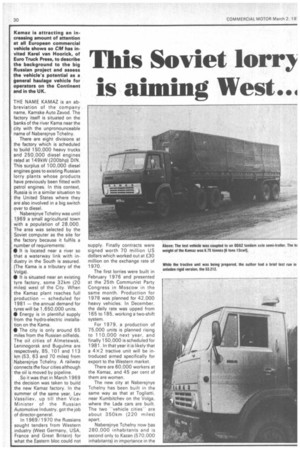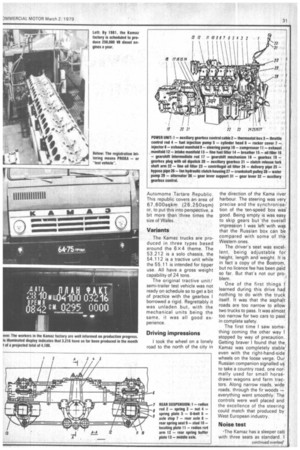This Soviet lorr
Page 32

Page 33

Page 34

If you've noticed an error in this article please click here to report it so we can fix it.
is awning West.. 1 Kamaz is attracting an increasing amount of attention at all European commercial vehicle shows so CM has invited Karel van Hoorick, of Euro Truck Press, to describe the background to the big Russian project and assess the vehicle's potential as a general haulage vehicle for operators on the Continent and in the UK.
THE NAME KAMAZ is an abbreviation of the company name, Kamske Auto Zavod_ The factory itself is situated on the banks of the river Kama near the city with the unpronounceable name of Naberejnye Tchelny.
There are eight divisions at the factory which is scheduled to build 150,000 heavy trucks and 250,000 diesel engines rated at 149kW (200bhp) DIN. This surplus of 100,000 diesel engines goes to existing. Russian lorry plants whose products have previously been fitted with petrol engines. In this context, Russia is in a similar situation to the United States where they are also involved in a big switch over to diesel,
Naberejnye Tchelny was until 1969. a small agricultural town with a population of 28,000. The area was selected by the Soviet computer as the site for the factory because it fulfils a number of requirements
• It is located near a river so that a waterway link with industry in the South is assured. (The Kama is a tributary of the Volga).
• It is situated near an existing tyre factory, some 32km (20 moles) west of the City. When the Kamaz plant reaches full production — scheduled for 1 981 — the annual demand for tyres will be 1,650,000 units.
• Energy is in plentiful supply from the hydro-electric installation on the Kama.
• The city is only around 65 miles from the Russian oilfields. The oil cities of Alrnetewsk, Leninogorsk and Bugulma are respectively, 85, 101 and 113 km (53, 63 and 70 miles) from Naberejnye Tchelny. A railway connects the four cities although the oil is moved by pipeline.
So it was that in March 1 969 the decision was taken to build the new Kamaz factory. In the summer of the same year, Lev Vassiliev, up till then Vice Ministerof the Russian Automotive Industry, got the job of director-general.
In 1969/1970 the Russians sought tenders from Western industry (West Germany, USA, France and Great Britain) for what the Eastern bloc could not supply. Finally contracts were signed worth 70 million US dollars which worked out at £30 million on the exchange rate of 1970.
The first lorries were built in February 1976 and presented at the 25th Communist Party Congress in Moscow in the same month. Production for 1978 was planned for 42,000 heavy vehicles. In December, the daily rate was upped from 165 to 185, working a two-shift system.
For 1979, a production of 75,000 units is planned rising to 110,000 next year, and finally 150,000 is scheduled for 1981. in that year it is likely that a 4 x 2 tractive unit will be introduced aimed specifically for export to the Western market.
There are 60,000 workers at the Kamaz, and 45 per cent of them are women.
The new city at Naberejnye Tchelny has been built in the same way as that at Togliatti, near Kumbitchev on the Volga, where the Leda cars are built. The two -vehicle citiesare about 350km (220 miles) .apart,
Naberejnye Tchelny now has 280,000 inhabitants and is second only to Kazan (570,000 inhabitants) in importance in the Automome Tartare Republic. This republic covers an area of 67,600sqkm (26,250sqm) or, to put this into perspective, a bit more than three times the size of Wales,
Variants
The Kamaz trucks are produced in three types based around the 6><4 theme. The 53.212 is a solo chassis, the 54.112 is a tractive unit while the 55.11 is intended for tipper use. All have a gross weight capability of 24 tons.
The original tractive unit/ semi-trailer test vehicle was not ready on schedule so to get a bit of practice with the gearbox I borrowed a rigid. Regrettably it was unladen but, with the mechanical units being the same, it was all good experience.
Driving impressions
I took the wheel on a lonely road to the north of the city in the direction of the Kama river harbour. The steering was very precise and the synchronisation of the ten-speed box was good. Being empty is was easy to skip gears but the overall impression I was left with was that the Russian box can be compared with some of the Western ones.
The driver's seat was excellent, being adjustable for height, length and weight. It is in fact a copy of the Bostrom, but no licence fee has been paid so far, But that's not our problem.
One of the first things I learned during this drive had nothing to do with the truck itself. It was that the asphalt roads are too narrow to allow two trucks to pass. It was almost too narrow for two cars to pass in complete safety.
The first time I saw something coming the other way I stopped by way of precaution. Getting braver I found that the Kamaz was completely stable even with the right-hand-side wheels on the loose verge. Our Russian companion signalled us to take a country road, one normally used for small horsedrawn wagons and farm tractors. Along narrow roads, wide roads, through the fir woods — everything went smoothly. The controls were well placed and the excellence of the steering could match that produced by West European industry.
Noise test
The Kamaz has a sleeper cab with three seats as standard. I carried out a noise test with the windows shut and the Bruel and Kjaer noise meter held at ear level. During full acceleration at 50mph the level was 78dBA and on the overrun from 50mph the Kamaz recorded 76d BA.
Subjectively the noise was more than acceptable, permitting easy conversation across the cab or even listening to the radio. With 2,850rpm on the dial (slightly into the red!) the road speed was 106km/ h (66mph).
Finally, our laden tractive unit was ready. Although it had not done many miles our Russian friends assured me that it was well run in.
Using the same route, the difference in performance was, not surprisingly, very noticeable especially from eighth gear upwards. Without much trouble, we reached 64km /h (40mph) at which speed the engine was doing 1,900rpm. At this speed you could really feel the engine torque.
After a few miles it began to rain which affected the visibility because, although the wash/ wipe kept the front screen clear, the side windows and mirrors were quickly covered in mud. In order to see anything at all from behind I had to keep the side window open. The excellent heater meant that this was not a problem as far as the cold was concerned, but my shirt and tie ended up being splattered with mud!
As we drove into the port the evening rush hour was beginning so we drove out on to the ring road and headed off in the direction of the airport to the south of the city.
Turning round at the airport we headed back towards the factory again catching part of the heavy city traffic. Our round trip of 144km (70 miles) had taken 2 hours and 25 minutes for an average speed (Including the heavy traffic situation) of 47km/ h (29mph).
The factory driver had to do a very tricky manoeuvre at the end of the test (about 60 yards in reverse on a curved road) to reach the factory garage fuel pump. The overall fuel consumption worked out at 42.8 lit/100km (6,6mpg), which is on the high side, but then the test did include two sections in the Naberejnye Tchelny rush hour — not ideal conditions for a heavy truck consumption test.
am amazed that the average speed was as high as it was. Although I'm no prophet, I think that a fuel consumption of 37 lit/100km (7.6mpg) would be nearer the mark for general road use.
An interesting possibility for the future will be a 4 x 2 Kamaz. tractive unit on Michelin X tyres aimed at the Western market. And it is a definite possibility.












































































































